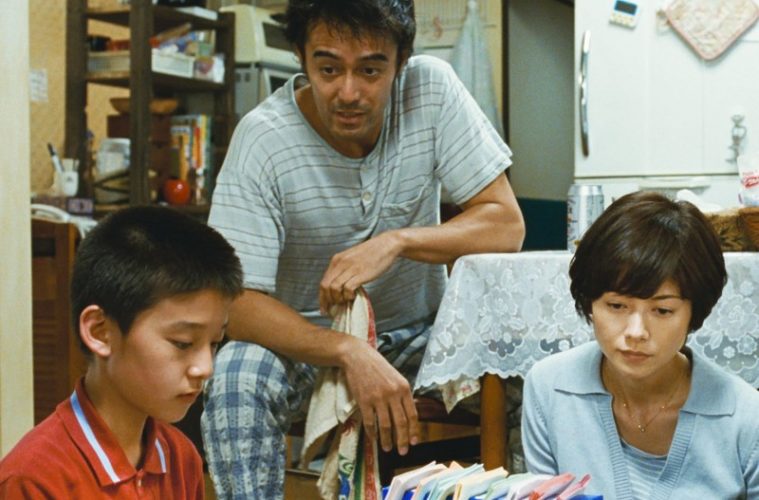
There is no filmmaker in the world more attuned to the complexities of family life than Japan’s Hirokazu Kore-eda. Consider the emotional upheaval that faces the parents and children of 2013’s Like Father, Like Son, or the relationship between the sisters of 2015’s Our Little Sister. Koreeda’s latest film following those two gems, After the Storm, continues his warm but ever-truthful gaze at what bonds people together. (Film Movement opens Storm on March 17 in New York and Los Angeles.)
Set against the backdrop of an approaching typhoon, Storm is the story of a failing author (Hiroshi Abe) struggling to pay his child support, and his attempts at rebuilding relationships with his son (Taiyo Yoshizawa) and ex-wife (Yoko Maki). As sweet and funny as the last two great Kore-eda films, Storm also has the sharp insight of earlier masterpieces like Nobody Knows and Still Walking.
Currently working on his next film, Kore-eda answered some brief questions about Storm, working with his “alter-ego” Hiroshi Abe, and his experience directing child actors.
The Film Stage: After the Storm continues your focus on the shifting dynamics of family. What drew you to this story of a father and son, and this stage of their lives?
Hirokazu Kore-eda: I wanted to depict the concept of fatherhood with this film. [In addition], I wanted to make a film that cuts out a part of one’s long life. I think a part of life is better.
Did the idea of the typhoon come before or after the rest of the story?
 I had the idea of a typhoon from the very beginning. I actually started to write the script on the night of a typhoon. After my father passed away, my mother started living by herself in the housing complex where I grew up. When I went back home for the New Year, I noticed the changes. The kids had left, and only the trees had remained and grown up. Seeing this gave me the idea to make a film about the housing complex. The first scene that came to mind was a walk through the complex with grass that had become very beautiful in the morning after a typhoon. Since I was a child I’ve always wondered why the complex was so beautiful after a typhoon. Though nothing changes, it seems like a complete transformation happened overnight. I wanted to describe that moment… Although a typhoon can destroy ordinary life, in most cases it purifies everyday living.
I had the idea of a typhoon from the very beginning. I actually started to write the script on the night of a typhoon. After my father passed away, my mother started living by herself in the housing complex where I grew up. When I went back home for the New Year, I noticed the changes. The kids had left, and only the trees had remained and grown up. Seeing this gave me the idea to make a film about the housing complex. The first scene that came to mind was a walk through the complex with grass that had become very beautiful in the morning after a typhoon. Since I was a child I’ve always wondered why the complex was so beautiful after a typhoon. Though nothing changes, it seems like a complete transformation happened overnight. I wanted to describe that moment… Although a typhoon can destroy ordinary life, in most cases it purifies everyday living.
You work so well with children, in this case actor Taiyo Yoshizawa. Do you direct your young actors differently than your adult actors? Are there any other filmmakers whose work with children has influenced your approach?
Usually I don’t provide a script to kid actors. I only explain to them the setting of a scene and give them the dialogue verbally without telling them the whole story of the film. I don’t know if I am influenced by others, but if so, it’d be Hou Hsiao-Hsien’s films, Ken Loach’s Kes, and Robert Benton’s Kramer vs. Kramer.
See Also: Hirokazu Kore-eda’s 10 Favorite Films
You’ve worked with Hiroshi Abe before. What made him right for this role?
In my 40s and 50s, I identified with the roles that Abe played in Still Walking and the TV series Going Home, so he is special for me. He is like my alter-ego. After Still Walking, both of us became fathers, and I think this is reflected in our characters. I think it’s wonderful that a director, an actor, and the roles we create grow up together.
Your films are known for their emotional impact, but also their warmth. When dealing with a drama such as After the Storm, how do you juggle the heavier, dramatic elements with the humor that’s also a trademark of your work?
I want to add the serious sequences into scenes of ordinary living. I think people tend to laugh when they want to cry. It applies to the feelings of characters and audiences as well.
What can you tell us about your upcoming film, The Third Murder?
I’m still in the process of editing the film, but the story is about an attorney, a murderer, and the family of a victim.

After the Storm hits theaters on Friday, March 17. See the theatrical roll-out here.

